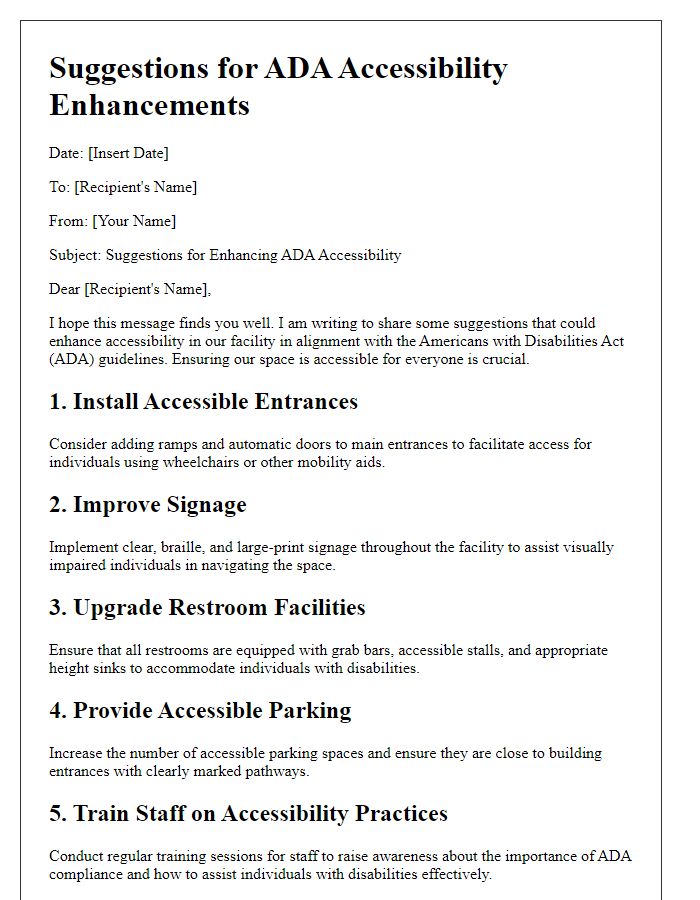Welcome to our guide on crafting the perfect letter for ADA accessibility compliance feedback! Navigating the intricacies of the Americans with Disabilities Act can be tricky, but expressing your thoughts and suggestions in a clear and effective manner is essential. In this article, we'll explore tips on how to articulate your feedback while ensuring it resonates with the recipient. Ready to dive into the nitty-gritty of ADA compliance communication? Keep reading!

Clear and concise language
ADA (Americans with Disabilities Act) accessibility compliance feedback should be direct and specific to enhance understanding. Feedback should address physical accessibility features, such as ramps, elevators, and door widths in public facilities like libraries and shopping centers. Additionally, digital accessibility for websites or applications should focus on navigation features, text alternatives for images, and compatibility with screen readers. Emphasis on clear signage (with adequate font size and contrast) promotes navigation ease for individuals with visual impairments. Regular assessments of compliance with ADA standards are crucial and should include input from individuals with disabilities to ensure comprehensive feedback and improvements.
Specific feedback on accessibility barriers
Accessibility barriers in public spaces often hinder individuals with disabilities, impacting their mobility and overall experience. For instance, the absence of wheelchair ramps at entry points, particularly in busy venues like shopping centers, can limit access for those using mobility devices. Inadequate signage with low-contrast color schemes and small fonts in places such as airports can create challenges for individuals with visual impairments. Additionally, narrow aisles in restaurants may obstruct the movement of patrons using assistive devices, leading to a negative dining experience. Furthermore, lack of auditory signals at crosswalks in urban areas can pose safety risks for individuals who are blind or have low vision, emphasizing the need for comprehensive compliance with the Americans with Disabilities Act (ADA) standards.
References to ADA guidelines
The Americans with Disabilities Act (ADA) emphasizes the importance of accessibility in public spaces, ensuring individuals with disabilities can navigate environments freely. Key elements of compliance include wheelchair ramps measuring at least 36 inches in width, ensuring doorways have a minimum height clearance of 80 inches, and providing accessible restroom facilities equipped with grab bars, adequate turning space, and accessible sinks. Additionally, the ADA mandates that signage should incorporate Braille and large print for individuals with visual impairments, while elevators must be available in multi-story buildings to comply with accessibility standards. Regular audits on accessibility features, such as parking spaces designated for individuals with disabilities, can enhance compliance with these guidelines, fostering inclusivity in public spaces.
Suggested improvements or solutions
ADA accessibility compliance feedback highlights the necessity of creating inclusive environments for individuals with disabilities. Key areas for improvement include the installation of automatic door openers in public buildings such as libraries, ensuring compliance with the Americans with Disabilities Act (ADA) standards for door width and ease of access. Clear signage featuring Braille and high-contrast text in facilities like hospitals enhances navigability for visually impaired individuals, meeting ADA requirements. Additionally, implementing wheelchair-friendly ramps and elevators in multi-story buildings ensures accessibility for those using mobility aids. Regular training for staff on sensitivity to disability issues fosters an inclusive atmosphere and aligns with ADA compliance goals. Addressing these areas promotes equal access and encourages community engagement, benefiting a diverse population.
Contact information for further discussion
Providing feedback regarding ADA (Americans with Disabilities Act) accessibility compliance is crucial for ensuring that places, services, and resources are accessible to individuals with disabilities. Contact information for further discussion can include details such as the name of the organization or individual responsible, phone numbers (e.g., area code 555-123-4567), email addresses (e.g., feedback@example.com), and physical addresses (e.g., 123 Main Street, Anytown, USA). Additionally, it's useful to outline the best times for contact and specify the preferred communication method to facilitate a productive dialogue. This ensures that concerns are addressed promptly and that all necessary adjustments can be discussed effectively.













Comments